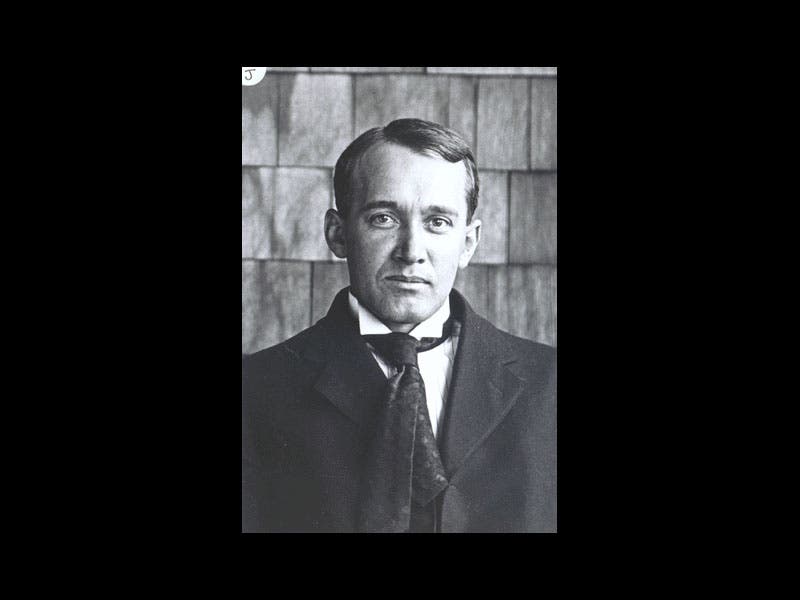 Image 1 Caption:
The staff of the
Lowell Observatory (1894--)
in Flagstaff, Arizona
with the
Clark
Refractor (primary diameter 24 inches = 0.6096 m, c.1894--)
in 1905.
Left to
right:
Harry Hussey (fl. 1905, janitor),
Wrexie Leondard (1867--1937),
Vesto Slipher (1875--1969),
Percival Lowell (1855--1916), Carl Otto Lampland (1873--1951),
John Charles Duncan (1882--1967).
Image 1 Caption:
The staff of the
Lowell Observatory (1894--)
in Flagstaff, Arizona
with the
Clark
Refractor (primary diameter 24 inches = 0.6096 m, c.1894--)
in 1905.
Left to
right:
Harry Hussey (fl. 1905, janitor),
Wrexie Leondard (1867--1937),
Vesto Slipher (1875--1969),
Percival Lowell (1855--1916), Carl Otto Lampland (1873--1951),
John Charles Duncan (1882--1967).
 Image 2 Caption:
Vesto Slipher (1875--1969)
of Lowell Observatory in
Flagstaff, Arizona.
Image 2 Caption:
Vesto Slipher (1875--1969)
of Lowell Observatory in
Flagstaff, Arizona.
Features:
- Vesto Slipher (1875--1969)
working at
Lowell Observatory
began starting in 1912
an observational program of measuring the
redshifts
of galaxies
(see No-522--523).
Slipher's measurements were all in the visible band (fiducial range 0.4--0.7 μm =400--700 nm = 4000--7000 Å) since he had NO ultraviolet NOR infrared measurement capability. He probably mostly measured the hydrogen Balmer lines (i.e., the visible band atomic hydrogen lines). Since galaxies are made of stars, their overall spectra are a kind of star average in which the hydrogen Balmer lines would be seen as absorption lines as in stellar spectra.
- Slipher, of course,
did NOT know
the nebulae (historical usage)
(i.e., spiral nebulae
and elliptical nebulae)
were
galaxies for sure until
Edwin Hubble's (1889--1953)
convincing proof in 1924 of the galactic nature of
the spiral nebulae
and,
the elliptical nebulae (by
immediate implication since
they were in galaxy clusters
with spiral nebulae)
(see Wikipedia:
Edwin Hubble: Universe goes beyond the Milky Way galaxy).
Note,
spiral galaxies and
elliptical galaxies
were then called
nebulae, a term
which we now use for galaxies
only when speaking historically.
- Most galaxies showed
redshifts.
A very few showed
blueshifts which we regard as
negative
redshifts.
- By 1925,
Slipher
had redshifts for
45
galaxies
(see No-522--523).
This is very slow progress by modern standards, but
"sufficient unto the day
is the technique thereof".
-
Interpreted as
Doppler shifts---which, in fact, is
NOT exactly right---though that is what was assumed originally by
Slipher and, perhaps for awhile, by
Edwin Hubble (1889--1953)---these
results showed that
most galaxies (the redshifted ones) were moving away from us.
The blueshifted galaxies are moving toward us.
Originally, Slipher and, perhaps for awhile, Hubble assumed the shifts were entirely Doppler shifts. This is a wrong assumption. Most of the shifting is cosmological redshift.
The somewhat wrong assumption did NOT hurt much since the 1st order Doppler effect formula coincidentally gives the right answer anyway for recession velocities for relatively nearby galaxies which were all Slipher measured redshifts for.
- Using the
1st order Doppler effect formula,
the
recession velocities
of the observed galaxies were known.
- The upshot of Slipher's work
was that most galaxies were in relative motion away from
Milky Way.
Alternatively, one could hypothesize that the Milky Way was at the center of an outward flow of galaxies.
But that hypothesis violates the Copernican principle that we occupy NO special place in the universe.
- By the by,
in yours truly's days in
Flag,
yours truly learnt that old
Vesto was also a
real estate developer---West Saturn Way,
Meteor Drive, etc.---he made a killing.
- Image 3 Caption: The Slipher Rotunda Museum at the Lowell Observatory in Flagstaff, Arizona.
- This may be the dome where Vesto Slipher (1875--1969) discovered the systematic cosmological redshift of the galaxies---but no one's telling.
- Despite spending a year Flag (2010 Aug--2011 May) and visiting the Lowell Observatory several times, yours truly never noticed the Slipher Rotunda Museum---yours truly was probably just being obtuse.
- Image 3 Caption: The Slipher Rotunda Museum at the Lowell Observatory in Flagstaff, Arizona.
-
Images:
- Credit/Permission:
Anonymous photographer?,
1905
(uploaded to
Wikimedia Commons
by User:Victuallers,
2016) /
Public domain.
Image link: Wikimedia Commons: File:Group at Clark Telescope in 1905.jpg.
- Credit/Permission: Anonymous photographer, 1909 / Public domain
